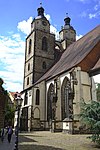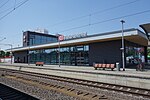Lutherhaus

The Lutherhaus is a writer's house museum in Lutherstadt Wittenberg, Germany. Originally built in 1504 as part of the University of Wittenberg, the building was the home of Martin Luther for most of his adult life and a significant location in the history of the Protestant Reformation. Luther was living here when he wrote his 95 Theses. The Augusteum is an expansion to the original building that was constructed after Luther's death to house a Protestant seminary and library which still exist today. Since 1996, both buildings have been recognized as UNESCO World Heritage Sites along with other sites associated with Martin Luther in Wittenberg and Eisleben, because of their religious significance and testimony to one of the most influential figures of medieval Europe.
Excerpt from the Wikipedia article Lutherhaus (License: CC BY-SA 3.0, Authors, Images).Lutherhaus
Collegienstraße,
Geographical coordinates (GPS) Address External links Nearby Places Show on map
Geographical coordinates (GPS)
| Latitude | Longitude |
|---|---|
| N 51.864611111111 ° | E 12.652722222222 ° |
Address
Augusteum
Collegienstraße 54
06886 , Altstadt (Wittenberg)
Saxony-Anhalt, Germany
Open on Google Maps





